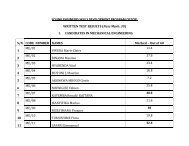lois et reglements police de roulage avec amendements
lois et reglements police de roulage avec amendements
lois et reglements police de roulage avec amendements
You also want an ePaper? Increase the reach of your titles
YUMPU automatically turns print PDFs into web optimized ePapers that Google loves.
oth ways for any driver) or with no C,2b signal (no entry from both ways for any driver, local<br />
traffic except).<br />
Where traffic <strong>de</strong>viation is required, it is signalled, at the beginning and all the way long, by<br />
means of an indicator signal shown un<strong>de</strong>r n° E,5a or E,5c of Annex 4 of this Decree.<br />
e) Where the beginning of the <strong>de</strong>viation does not coinci<strong>de</strong> with the beginning of the site, one n°<br />
C,2b signal will be placed near n° E,5a or E,5c signal.<br />
f) B<strong>et</strong>ween nightfall and daybreak, the barrier and the signals are lit and red traffic lights are<br />
placed across the sector of the public highway prohibited to circulation and at a maximal<br />
distance of one m<strong>et</strong>re from each other. All along the si<strong>de</strong> where users move, the site is shown by<br />
means of white or yellowish traffic lights placed at a minimal distance of 30 m<strong>et</strong>res from each<br />
other.<br />
3. The barrier is constituted either by a rope 0,10 to 0,20 m<strong>et</strong>re wi<strong>de</strong>, placed at a height of 0,80<br />
to 1,10 m above the ground, or by spi<strong>de</strong>rs 0,05 to 0,10 m<strong>et</strong>re wi<strong>de</strong>.<br />
The rope and spi<strong>de</strong>rs are divi<strong>de</strong>d into lengths of about 0,50 m, alternately red and white and<br />
provi<strong>de</strong>d with reflecting <strong>de</strong>vices or products.<br />
4. Signals used for the signalling of sites must have the following dimensions:<br />
a) danger signal: 0,90 m<strong>et</strong>re by si<strong>de</strong>. But, when fixing conditions so impose, that dimension can<br />
be reduced to 0,70 m<strong>et</strong>re;<br />
b) prohibition and obligation roadsigns: 0,70 m<strong>et</strong>re in diam<strong>et</strong>er.<br />
These signals must be ma<strong>de</strong> visible b<strong>et</strong>ween nightfall and daybreak, by means of either public<br />
lighting, or reflecting products; when weather is clear, the visibility distance must be at least<br />
100 m<strong>et</strong>res.<br />
Chapter 6. MISCELLANEOUS PROVISIONS<br />
Article 115:<br />
Road signals referred to in Articles 92 to 103 must as far as concerns shape, colours, symbols<br />
and inscriptions, conform to mo<strong>de</strong>ls shown in Annexes 1 to 4 of this Decree.<br />
Article 116:<br />
1. On roads <strong>de</strong>signated by the Minister having Public Works in his remit, the danger signals and<br />
indication signals must be ma<strong>de</strong> visible, b<strong>et</strong>ween nightfall and daybreak, by means either of<br />
special lighting or reflecting products, and when the weather is clear visibility distance must be<br />
of 100 m<strong>et</strong>res at least.<br />
2. On these roads, prohibition and obligation signals must be ma<strong>de</strong> visible in the same<br />
conditions when users are expected to abi<strong>de</strong> by them day and night.<br />
3. Signals B;7a and B,7b must always be lit or reflecting so as to be visible, when the weather is<br />
clear, at a distance of at least 100 m<strong>et</strong>ers.<br />
Article 117:<br />
It is prohibited to attach to a traffic signal any mention at variance with its purpose.<br />
However, danger signals, signal n°B,1 (cross-road where the driver must give way to those<br />
circulating on the way he is ready to turn in) except and indication signals may bear the name of<br />
the donor or of the company that has been authorised to fix the signals, on condition that these




